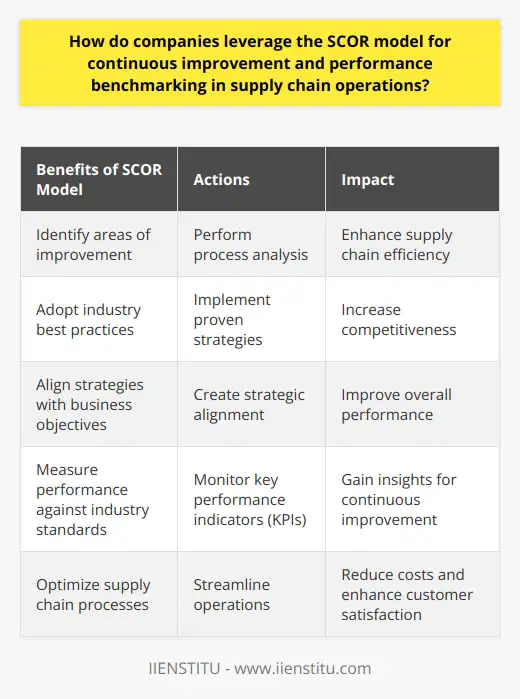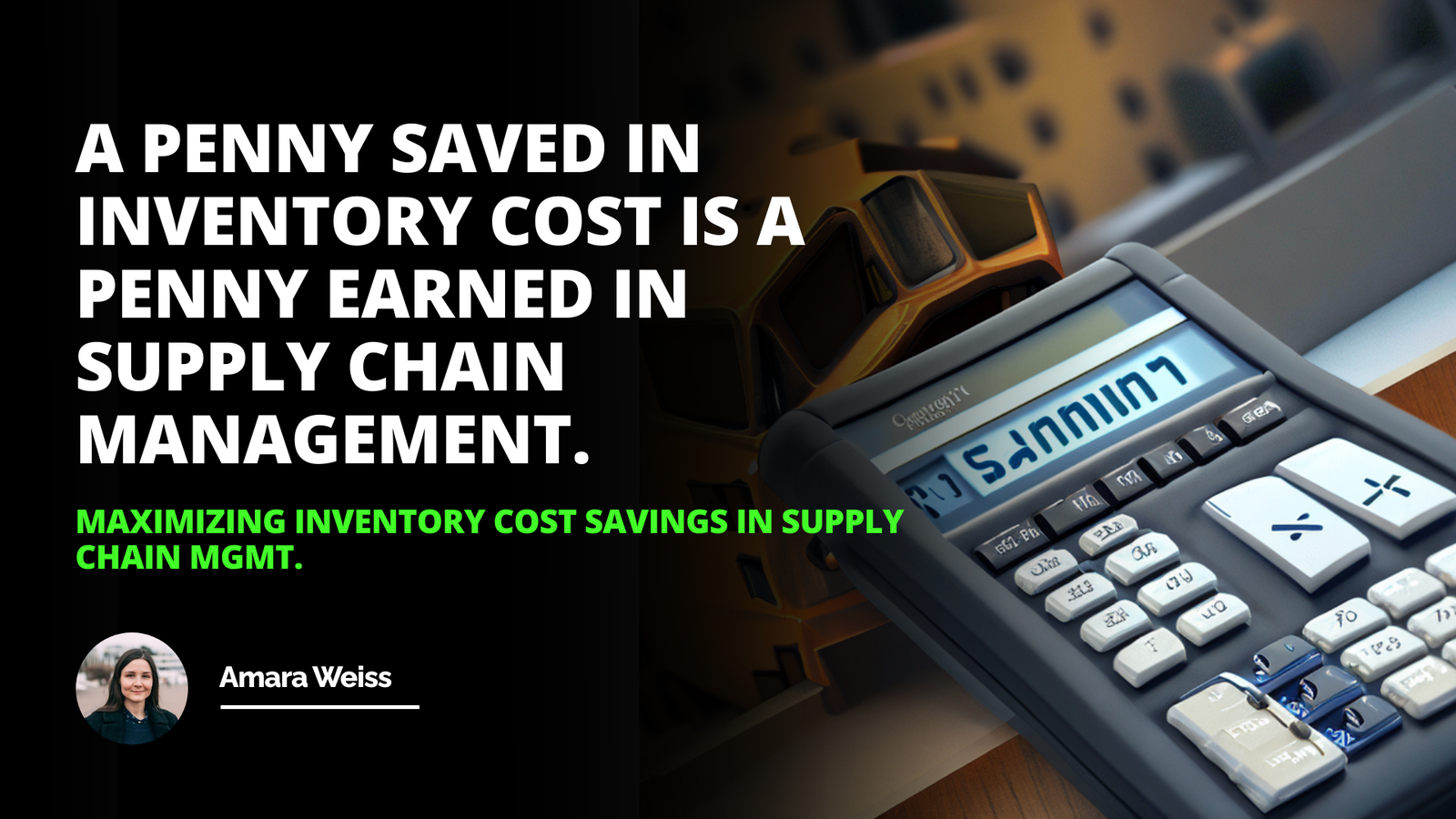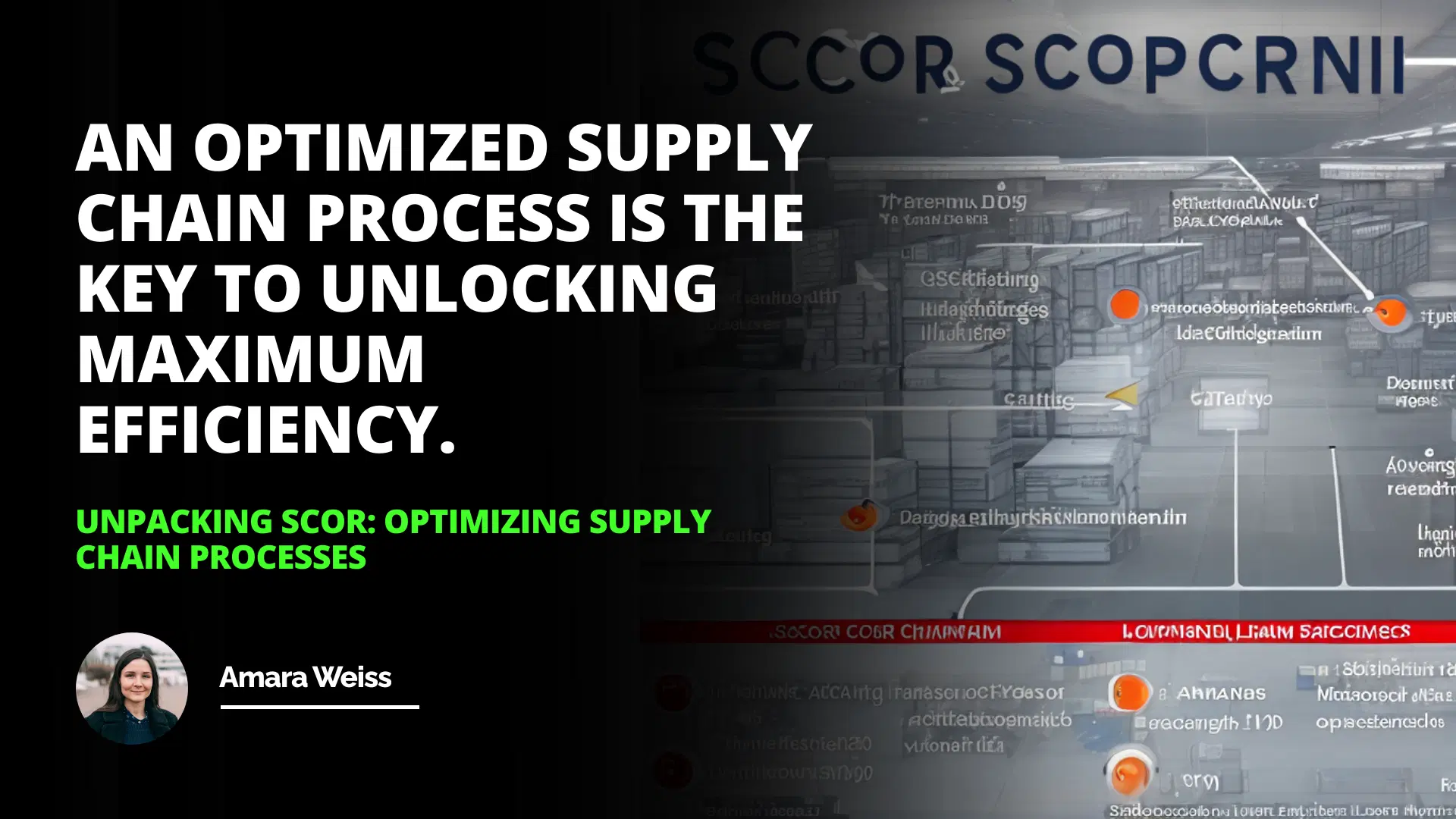
The Supply Chain Operations Reference (SCOR) Model is a widely used framework for analyzing and managing supply chain processes. It breaks the supply chain into five key processes: plan, source, make, deliver, and return. Organizations can optimize their supply chains by identifying inefficiency and using technology to automate processes. Additionally, organizations can capture value through reverse supply chains by recovering and reusing products and materials. Other processes that make a supply chain run efficiently include inventory management, Demand Planning, and transportation management.
Introduction
What is the SCOR Model?
Optimizing Supply Chain Processes
Reverse Supply Chains and Capturing Value
Other Processes That Make a Supply Chain Run Efficiently
Introduction: In today’s complex and globalized world, the success of businesses depends on their ability to manage their supply chain processes effectively. Supply Chain Management (SCM) is a critical component of any successful organization, and it involves the planning, procurement, production, and delivery of goods and services. Organizations must have an effective strategy to manage the various processes involved to ensure the efficient operation of a supply chain. One of the most commonly used models for managing supply chain processes is the Supply Chain Operations Reference (SCOR) Model.
What is the SCOR Model?
The SCOR Model is a widely used framework for analyzing and managing supply chain processes. Developed by the Supply Chain Council, the SCOR Model provides a comprehensive framework for analyzing and optimizing supply chains. The model breaks down the supply chain into five key processes: plan, source, make, deliver, and return.
Each of these processes is further divided into sub-processes, further divided into activities. The model provides a comprehensive view of the entire supply chain, enabling organizations to identify opportunities for improvement and to develop strategies for optimizing their supply chains.
Optimizing Supply Chain Processes
Once an organization has identified the processes that make up its supply chain, it can begin to optimize those processes. Optimizing supply chain processes involves identifying areas of inefficiency, such as long lead times, high costs, and low customer satisfaction, and then developing strategies to address those issues.
One of the most effective strategies for improving supply chain processes is to use technology to automate processes and reduce manual labor. Automation can significantly reduce costs and lead times while also increasing customer satisfaction.
Reverse Supply Chains and Capturing Value
In addition to optimizing supply chain processes, organizations can also look for opportunities to capture value through reverse supply chains. Reverse supply chains involve the recovery and reuse of products and materials. Organizations can reduce waste and capture value from their supply chains by recovering and reusing products and materials. For example, an organization may recover and resell products that customers have returned or recycle materials that would otherwise be discarded.
Other Processes That Make a Supply Chain Run Efficiently
In addition to the five critical processes identified by the SCOR Model, several other processes make a supply chain run efficiently. These processes include inventory management, demand planning, and transportation management. Inventory management involves tracking and managing inventory levels to ensure that products are available when needed. Demand planning involves forecasting customer demand and ensuring that the right products are available at the right time. Finally, transportation management involves efficiently moving products from one location to another.
Conclusion: In conclusion, effective supply chain management is essential for the success of any organization. The SCOR Model provides a comprehensive framework for analyzing and optimizing supply chain processes. By breaking down the supply chain into its component processes, organizations can identify areas of inefficiency and develop strategies for improving those processes. In addition, organizations can look for opportunities to capture value through reverse supply chains and other processes that make a supply chain run efficiently.
An optimized supply chain process is the key to unlocking maximum efficiency.
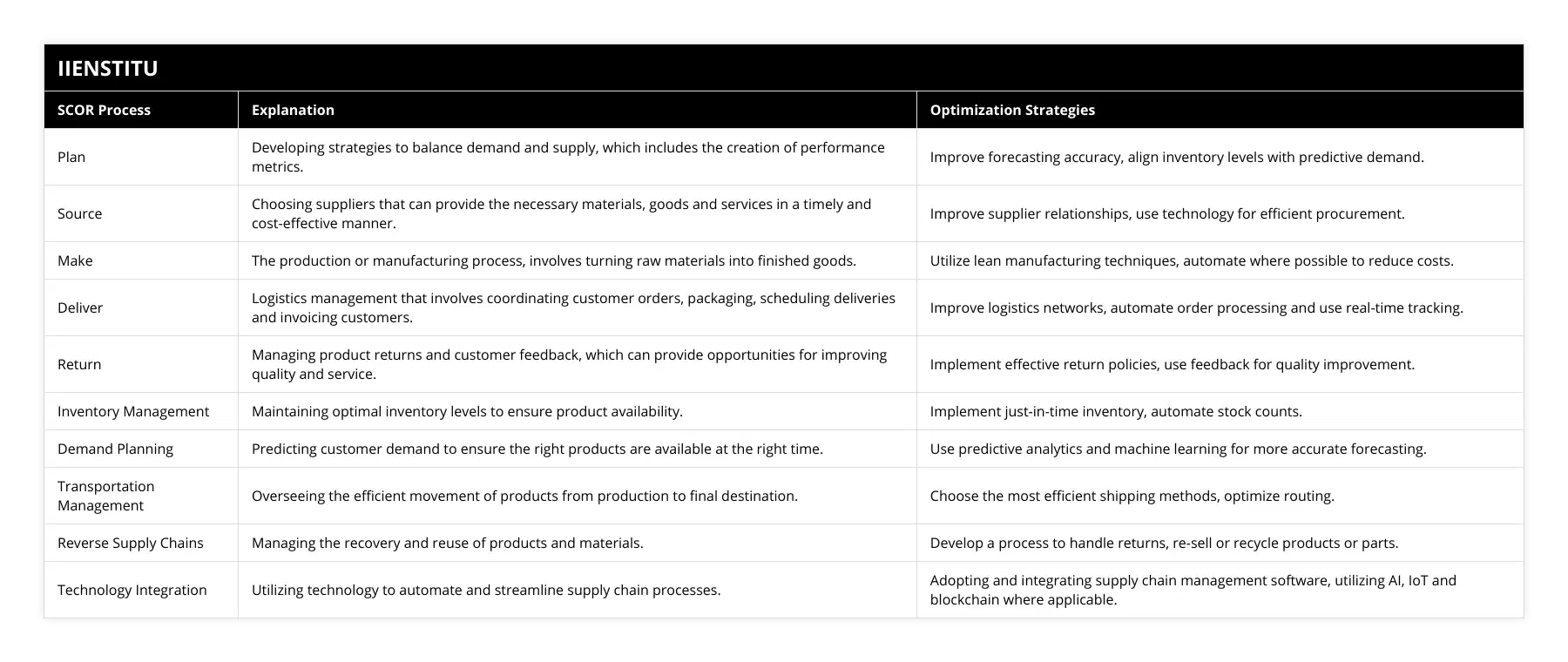
The SCOR model, a tool for managing supply chains, is crucial in successful operations within complex and globalized businesses. It highlights five key processes: plan, source, make, deliver, and return, to guide organizations in identifying inefficiencies and creating strategies for improvement. Utilizing technology to automate and upgrade these processes can enhance customer satisfaction while reducing costs and lead times. Further value can be captured through reverse supply chains by reusing and recovering products and materials. Other processes such as inventory management, demand, planning, and transportation management also contribute to a more efficient supply chain. For continued success, organizations should prioritize supply chain training to stay ahead in this critical business component.
Frequently Asked Questions
What are the key components of the SCOR Model?
The Supply Chain Operations Reference (SCOR) model is a business process framework developed by the Supply Chain Council (SCC) to provide organizations with a comprehensive, standardized framework for understanding, designing, and managing supply chain activities. The SCOR model is widely used in the supply chain industry and is considered the de facto standard for the supply chain management. The critical components of the SCOR model include the following:
1. Supply Chain Performance Metrics: These metrics allow organizations to measure the performance of their supply chain activities. The metrics are categorized into five performance areas: customer service, asset management, cost, quality, and cycle time. These metrics allow organizations to measure their supply chain performance and make decisions to improve it.
2. Process Reference Model: The process reference model allows organizations to map their supply chain activities and identify opportunities for improvement. The model includes the key activities and processes that make up the supply chain, including planning, sourcing, production, delivery, and customer service.
3. Supply Chain Network Model: The model allows organizations to identify and analyze the relationships between their suppliers and customers. The model helps organizations to develop an efficient and effective supply chain network by understanding the relationships between supply chain partners and identifying opportunities to optimize their supply chain.
4. Supply Chain Best Practices: The supply chain best practices allow organizations to identify and implement best practices across their supply chain. Best practices include lean manufacturing, Six Sigma, and total quality management.
5. Supply Chain Technology and Tools: The supply chain technology and tools allow organizations to use technology to improve their supply chain performance. Technologies such as enterprise resource planning (ERP), supply chain management (SCM), and advanced planning and scheduling (APS) systems help organizations to optimize their supply chain operations.
The SCOR model is a valuable tool for organizations to measure and improve their supply chain performance. By understanding the critical components of the SCOR model, organizations can develop a comprehensive view of their supply chain activities and identify opportunities for improvement.
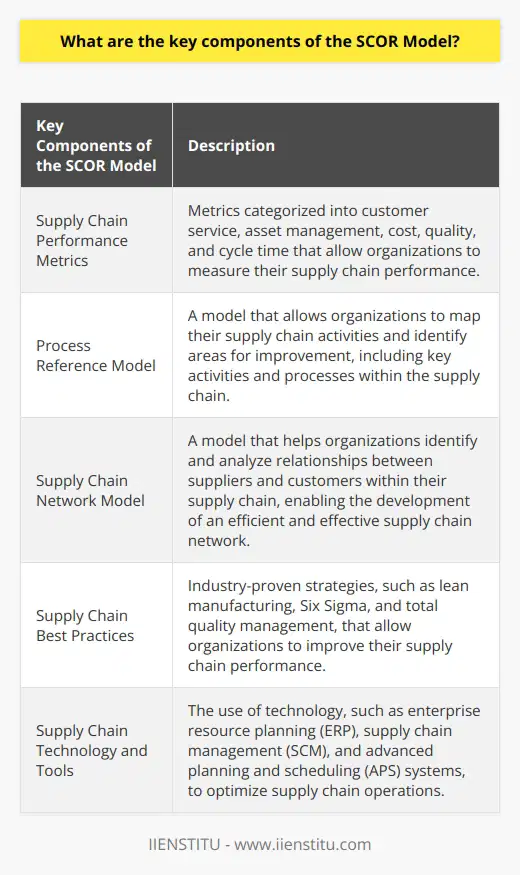
How can the SCOR Model be used to optimize supply chain processes?
The Supply Chain Operations Reference (SCOR) model is a comprehensive method for analyzing and optimizing supply chain processes. It is a well-known and widely accepted approach that many organizations use to improve their supply chain performance. The model comprises five components: Strategy and Policy, Design, Planning, Execution, and Performance Management. Each piece is designed to provide organizations with the necessary insights to improve supply chain processes and performance.
The SCOR model is based on the idea that supply chain performance can be improved by understanding the interrelationships between the components and activities of the supply chain. The model provides a framework for analyzing the processes, identifying areas of improvement, and developing strategies to optimize performance. For example, the Strategy and Policy component helps organizations develop and implement strategies aligned with their overall objectives.
The Design component enables organizations to identify and map the processes and activities that comprise the supply chain. The Planning component allows organizations to remember the resources, materials, and actions needed to execute the supply chain successfully. The Execution component enables organizations to monitor and evaluate the performance of the supply chain. Finally, the Performance Management component allows organizations to measure and analyze the supply chain's performance and identify improvement areas.
Organizations can gain valuable insights into their supply chain processes and performance using the SCOR model. This information can then be used to develop strategies and tactics to optimize the supply chain. For example, organizations can use the model to identify areas of inefficiency, such as delays or bottlenecks, and develop strategies to reduce these issues. Additionally, the model can identify cost savings opportunities and improve the overall efficiency of the supply chain.
In conclusion, the SCOR model is an effective tool for analyzing and optimizing supply chain processes. The model provides organizations with the necessary insights to develop strategies and tactics to improve the performance of the supply chain. Using the model, organizations can identify areas of inefficiency, develop strategies to reduce them, and identify cost savings opportunities.

What are the benefits of using the SCOR Model to manage supply chain operations?
The SCOR (Supply Chain Operations Reference) Model is a framework for managing supply chain operations developed by the Supply Chain Council. It is a process reference model that helps businesses optimize their supply chain operations. The SCOR Model provides several benefits to companies that use it to manage their supply chain operations.
Firstly, the SCOR Model provides a structured approach to supply chain management. It is designed to enable companies to evaluate their supply chain operations more holistically, as it takes into account all of the processes and components of the supply chain. By using the SCOR Model, companies can take a more comprehensive view of the supply chain and identify areas where improvements can be made.
Secondly, the SCOR Model can be used to develop and implement standardized processes throughout the supply chain. The SCOR Model provides a framework for designing and implementing consistent strategies, which can be replicated across the entire supply chain. This ensures that all processes are conducted similarly and that procedures are optimized for maximum efficiency. This helps to reduce costs, as well as improve overall performance.
Thirdly, the SCOR Model can be used to measure and evaluate the performance of the supply chain. The SCOR Model provides a set of metrics that can be used to measure performance, such as supply chain cycle time, order fulfillment time, and inventory turnover. This allows companies to track the performance of their supply chain over time and identify any areas for improvement.
Finally, the SCOR Model can be used to identify and analyze risk in the supply chain. The SCOR Model provides a framework to identify risks, such as supplier reliability, delivery time, and quality assurance. This allows companies to mitigate risk and improve their supply chain operations.
In conclusion, the SCOR Model provides several benefits to businesses that use it to manage their supply chain operations. First, it is a structured supply chain management approach, enabling companies to develop and implement standardized processes, measure and evaluate performance, and identify and analyze risks. As such, it is an invaluable tool for businesses looking to optimize their supply chain operations.
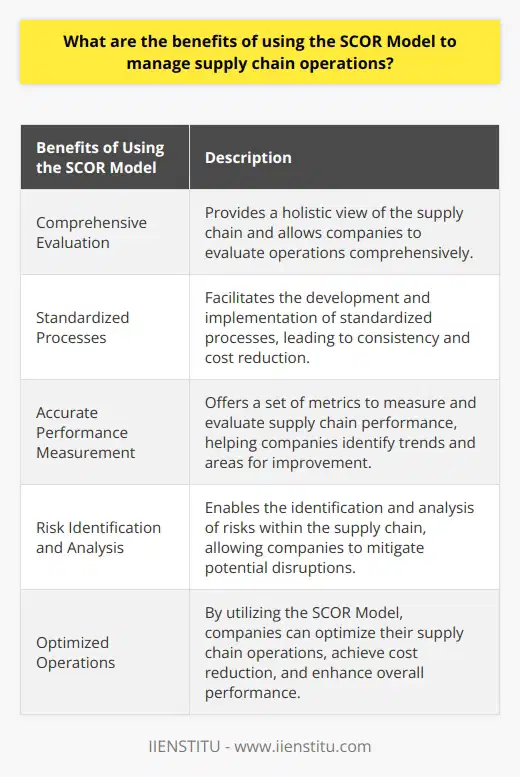
How do you optimize supply chain optimization?
Establishing Clear Objectives
To optimize supply chain management, it is essential to establish clear objectives that facilitate efficiency, reduce costs, and improve customer satisfaction. These objectives should be aligned with the organization's overall business strategy, ensuring that supply chain management contributes significantly to achieving the desired goals.
Streamlining Operations
Streamlining operations involves assessing the overall performance of the supply chain, identifying potential bottlenecks or inefficiencies, and implementing improvements. This can include restructuring warehouses, upgrading inventory management systems, or re-evaluating transportation routes. Simplifying operations improves supply chain management by reducing complexity and facilitating smoother processes.
Collaborating with Partners
Supply chain optimization requires effective collaborations with key partners, such as suppliers and logistics providers. Establishing strong relationships and maintaining open communication channels can enhance information sharing, support better decision making, and enable quicker adaptation to changing market conditions. By collaborating with partners, companies can ensure that their supply chain remains agile and competitive.
Investing in Technology
Technological advancements in logistics and supply chain management, such as artificial intelligence (AI), machine learning, and the Internet of Things (IoT), can provide substantial benefits when utilized effectively. These technologies enable real-time monitoring of operations, insightful data analysis, and precise demand forecasting, which can significantly improve the performance of supply chain management. Therefore, investing in technology has become indispensable for successfully optimizing a supply chain.
Emphasizing Risk Management
No supply chain is immune to disruptions or unforeseen challenges, such as extreme weather events, political instability, or system failures. To optimize supply chain performance, it is essential to proactively identify potential risks and develop robust contingency plans to mitigate their impact. By emphasizing risk management, companies can ensure that their supply chain remains resilient and adaptive in the face of challenges.
Promoting Sustainability
Another crucial aspect of supply chain optimization is the incorporation of sustainability practices, aiming to reduce environmental impact and increase social responsibility. Examples of such practices can involve adopting eco-friendly packaging, eliminating waste, or considering suppliers' ethical and environmental performance. A sustainable supply chain not only improves environmental outcomes but can also enhance a company's reputation and brand value, which ultimately contributes to overall business success.
In conclusion, supply chain optimization can be achieved through a multifaceted approach involving clear objectives, streamlined operations, collaboration, technological investment, risk management, and sustainability considerations. By addressing these key areas, companies can enhance their supply chain performance and drive overall business success.
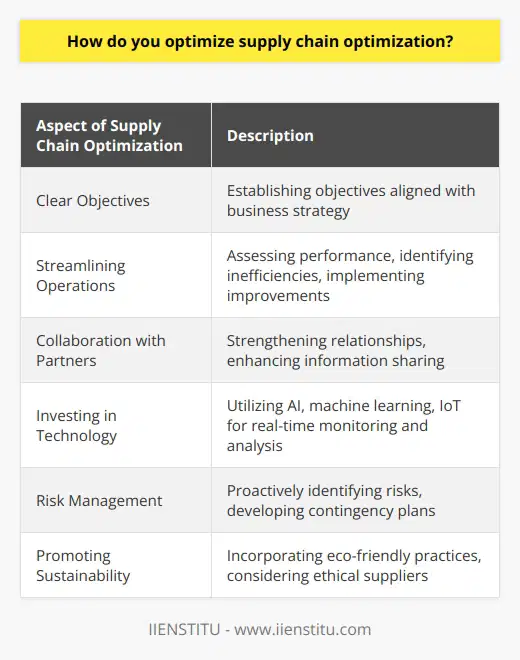
What is SCOR a model for improving supply chain management?
SCOR Model Introduction
SCOR, or the Supply Chain Operations Reference model, is a comprehensive framework that aims to improve supply chain management. This model was developed by a consortium called the Supply Chain Council (SCC), as a response to the increasing complexity and global nature of supply chains.
Five Major Processes of SCOR
SCOR is built on the foundation of five primary management processes: Plan, Source, Make, Deliver, and Return. These processes are interconnected and collectively contribute to the overall efficiency of a supply chain.
Plan: This process involves determining the demand-supply balance, organizing resources, and developing performance metrics to achieve strategic objectives.
Source: In this phase, companies select suppliers, negotiate contracts, and establish supplier performance metrics to ensure the procurement of high-quality materials and services.
Make: This entails the production of products, including scheduling, operations, and quality control measures to ensure optimal efficiency.
Deliver: This process covers order management, logistics, and customer service aspects of supply chain management, focusing on delivering products to customers in a timely and cost-effective manner.
Return: This involves handling returns, repairs, and recycling activities to address customer needs, regulatory compliance, and environmental concerns.
Benefits of Implementing SCOR
Companies that leverage the SCOR model can realize numerous benefits, which include:
Improved Performance: The model helps companies to benchmark their supply chain performance against industry best practices, identifying areas of improvement, and driving continuous improvement initiatives.
Enhanced Collaboration: By providing a shared language and framework, SCOR encourages communication and collaboration among various supply chain stakeholders, such as suppliers, manufacturers, and customers.
Increased Agility: By implementing an integrated approach, companies can quickly respond to changes in demand, supply, or market conditions, enabling them to maintain a competitive edge.
Greater Efficiency: The model serves to optimize supply chain processes, eliminate waste, and reduce costs, resulting in increased profitability for businesses.
Sustainability: SCOR provides guidelines on addressing environmental and social issues within supply chain operations, promoting responsible and sustainable practices.
Conclusion
In summary, the SCOR model is a valuable tool for improving supply chain management by connecting five key processes and offering a standardized framework for measuring and optimizing performance. Implementing the SCOR model enables companies to achieve greater efficiency, collaboration, agility, and sustainability within their supply chains, ultimately enhancing business performance and competitiveness.
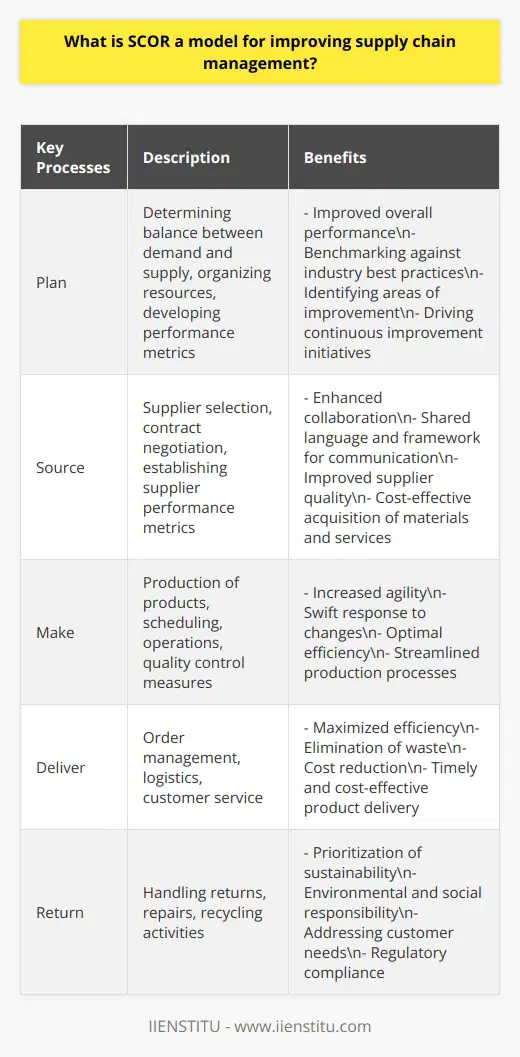
What are the 5 supply chain processes which are part of the SCOR model?
SCOR Model and Supply Chain Processes
SCOR, which stands for Supply Chain Operations Reference model, is a widely recognized framework that enhances supply chain management by measuring and assessing operations to identify gaps and suggest improvements. At its core, SCOR model consists of five primary supply chain processes: Plan, Source, Make, Deliver, and Return.
Planning Process
The planning process in the SCOR model revolves around creating a strategic plan that balances demand and supply, determining resource requirements, and setting performance metrics. This process helps organizations to effectively allocate resources and manage potential risks, ensuring smooth and optimized supply chain operations.
Sourcing Process
Sourcing focuses on identifying, selecting, and managing suppliers that can provide the required goods, services, or resources for a business. The process encompasses procuring raw materials, setting delivery schedules, and negotiating contracts with supplier partners. By streamlining the sourcing process, companies are able to maintain strong relationships with suppliers, leading to better quality and cost-effective products.
Making Process
The making process in the SCOR model concerns the actual production of products or provision of services. This process includes activities such as scheduling production, assembling goods, and ensuring quality control. An efficient making process allows businesses to meet customer demand while maintaining high-quality standards and controlling production costs.
Delivery Process
Delivery, also known as the logistics process, involves the transportation, distribution, and fulfilment of orders to customers. This process encompasses activities such as warehousing, order management, and transportation management. By effectively managing the delivery process, businesses can ensure timely and accurate deliveries, leading to increased customer satisfaction and loyalty.
Return Process
Lastly, the return process in the SCOR model refers to the management of returns, repairs, and recycling of products. This process is crucial for businesses to handle customer complaints, process refunds or replacements, and maintain a positive brand image. Additionally, the return process can provide valuable insights for continuous improvement in product design and manufacturing.
In conclusion, the SCOR model successfully captures the five primary supply chain processes, enabling businesses to analyze and optimize their operations to achieve a competitive advantage. By focusing on the Plan, Source, Make, Deliver, and Return processes, organizations are able to streamline their supply chain, minimize costs, and enhance customer satisfaction.
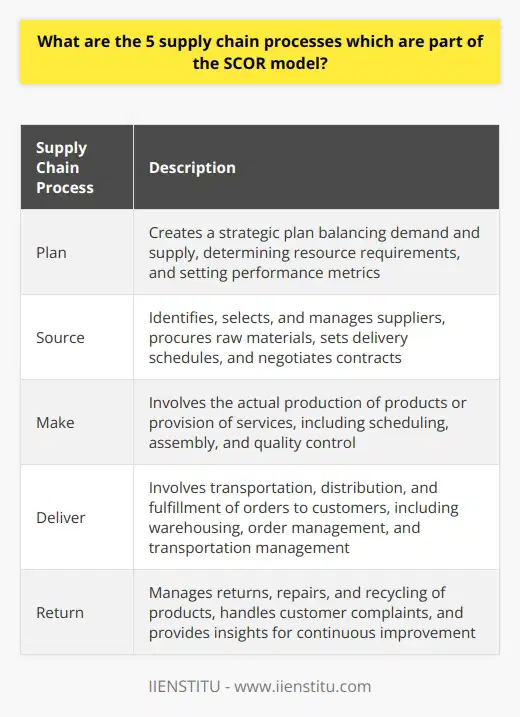
How do you optimize supply chain processes?
Understanding the Supply Chain
Optimizing supply chain processes is critical to ensure efficient business operations, minimize operational costs and increase customer satisfaction. A well-optimized supply chain includes effective planning, controlling product flow, and enhancing collaboration between suppliers and customers. Several essential strategies can improve supply chain performance, such as adopting advanced technologies, automating operations, and developing sustainable practices.
Implementing Advanced Technologies
The integration of advanced technologies like artificial intelligence (AI), machine learning, and the Internet of Things (IoT) can transform the traditional supply chain. By automating data analysis and decision making, organizations can enhance demand forecasting, reduce errors, and make informed modifications to improve system efficiency. Real-time monitoring of transportation logistics and warehouse management systems can optimize the product flow and minimize transit times, ultimately lowering costs and increasing customer satisfaction.
Automation and Robotics
Automation in supply chain processes helps reduce manual work, increase productivity, and minimize human error. By using robotics for tasks like order picking, packing, and transportation, businesses can ensure accuracy and speed in product delivery. Automation also enables companies to manage high-demand periods, reduce employee workload, and enhance the overall efficiency of operations. Furthermore, incorporating robotic process automation (RPA) can streamline back-end processes like procurement, invoicing, and contract management, freeing up resources for more strategic tasks.
Sustainable Supply Chain Practices
Prioritizing sustainable practices in the supply chain can lead to long-term benefits and improved performance. Organizations can optimize their processes by reducing waste, minimizing energy consumption, and utilizing renewable resources. This not only lowers operational costs but also contributes to a positive brand image and appeals to environmentally-conscious consumers. Companies should also prioritize social sustainability by ensuring ethical labor practices, fair wages, and a safe working environment for suppliers and employees.
Collaboration and Communication
Enhancing collaboration among supply chain partners is crucial for optimization. By sharing information and knowledge openly, companies can better anticipate challenges, manage risks, and identify opportunities for improvement. Establishing strong communication channels enables organizations to adapt to market changes, streamline operations, and align goals between stakeholders. Maintaining transparency throughout the supply chain fosters trust and long-term relationships, which in return contribute to the overall efficiency and success of the business.
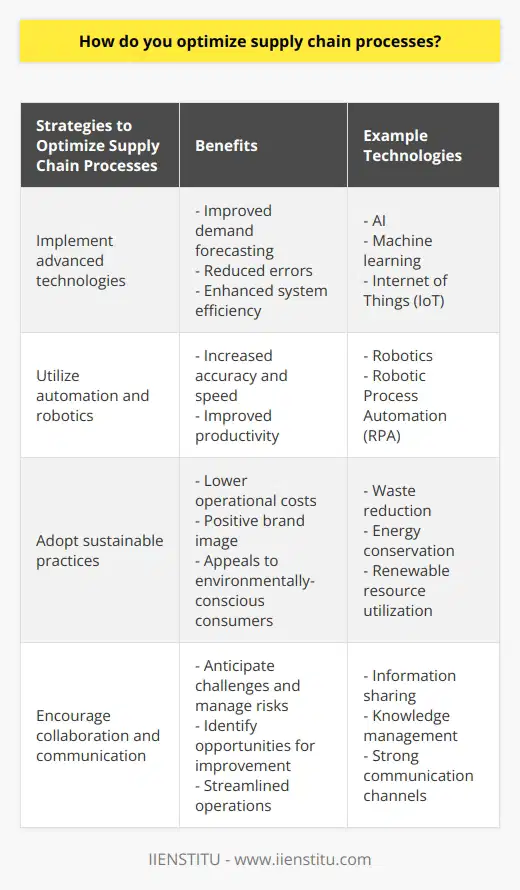
What are the 5 processes of SCOR?
Understanding the Five Processes of SCOR
Supply Chain Operations Reference (SCOR) is a framework that helps organizations enhance their supply chain performance. SCOR encompasses five primary management processes that guide supply chain operations: Plan, Source, Make, Deliver, and Return. These processes collectively provide a roadmap for integrating and streamlining supply chain functions to boost efficiency, productivity, and profitability.
Planning Process
The planning process involves devising effective strategies to balance demand and supply, optimize resources and align with the organization's overall objectives. This includes demand forecasting, production planning, inventory management, and capacity management. By implementing smart planning, companies can adapt to changing market conditions, minimize costs, and stay competitive.
Sourcing Process
The sourcing process focuses on procuring the necessary raw materials, components, and services to meet the organization's production requirements. Key activities include supplier management, contract negotiation, purchasing, and procurement. An optimized sourcing process can lead to reduced lead times, increased responsiveness and flexibility, and better control over supplier quality and performance.
Manufacturing Process
In the manufacturing process, companies convert raw materials into finished goods or services. This entails using production processes such as assembly, processing, or packaging, along with quality control measures and maintenance procedures. Efficient manufacturing practices enable businesses to optimize production capacity, reduce costs, maintain product quality, and enhance operational agility.
Delivery Process
The delivery process encompasses all the steps a company takes to deliver finished products or services to customers, including order management, transportation, warehousing, and fulfillment. By optimizing this process, organizations can improve on-time delivery, reduce transportation and logistics costs, increase customer satisfaction, and streamline overall supply chain operations.
Return Process
Finally, the return process involves managing product returns, customer claims, and end-of-life disposal. It is essential for organizations to have effective return policies and procedures in place to manage reverse logistics and maintain customer satisfaction. Proper returns management can result in reduced waste, better product quality, and improved environmental sustainability.
In conclusion, the five processes of SCOR—Plan, Source, Make, Deliver, and Return—provide a comprehensive framework for effectively managing and optimizing supply chain operations. By understanding and implementing these processes, organizations can drive significant improvements in efficiency, customer satisfaction, and profitability in their supply chains.
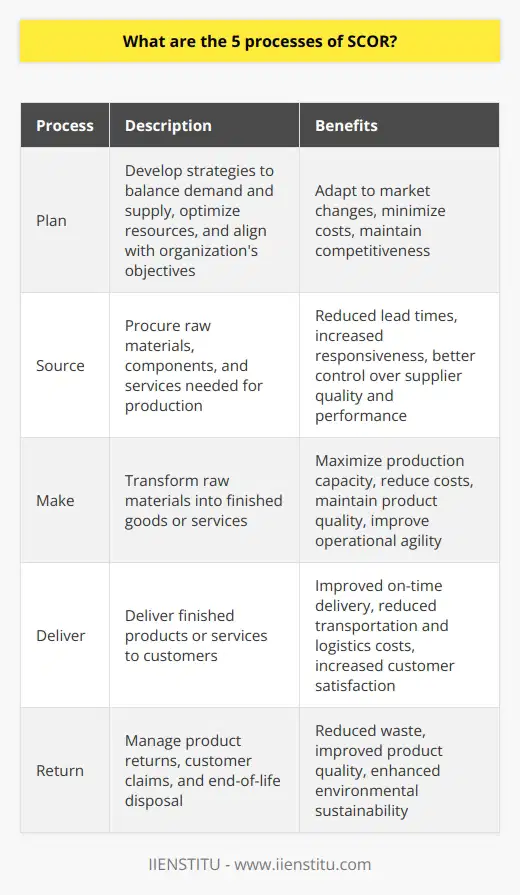
How the SCOR model helps to explain the processes along the entire supply chain?
Understanding the SCOR Model
The SCOR model, which stands for Supply Chain Operations Reference, is a vital tool created by the Supply Chain Council to streamline and optimize supply chain processes. It serves as a standardized platform that offers best practice approaches in measuring, managing, and improving supply chain performance. By examining the application of the SCOR model, one can comprehend how it explains and highlights the various stages involved in the entire supply chain.
Key Components of the SCOR Model
Three primary elements make up the SCOR model: Process modeling, performance measurement, and best practice analysis. Firstly, process modeling breaks down supply chain activities into fundamental categories, such as planning, sourcing, manufacturing, delivery, and return. It provides a hierarchical structure, enabling companies to seamlessly analyze each step and identify opportunities for optimization.
Promoting Efficiency through Measurement
The second element, performance measurement, is centered on evaluating key performance indicators (KPIs) and aligning them with strategic objectives. By analyzing these critical metrics, businesses can identify the effectiveness of their supply chain practices and implement necessary changes for improvement. The SCOR model provides a comprehensive set of standardized KPIs that offer a common benchmarking system for organizations within the same industry.
Best Practice Implementation
Finally, the SCOR model recognizes the importance of adopting best practices in supply chain management. It collects, analyzes, and disseminates essential industry knowledge for easy access and implementation across organizations. By following these best practices, companies can streamline their operations to achieve goals such as reducing costs, increasing customer satisfaction, and improving overall supply chain efficiency.
The Role of SCOR Model in Integration
Integration is an integral aspect of supply chain management, and the SCOR model plays a significant role in ensuring supply chain synergy. By providing a holistic view of the entire supply chain, it encourages coordination between supply chain partners and promotes collaboration to achieve mutual benefits. This collaborative environment enables companies to identify and mitigate potential risks, ultimately leading to a more resilient and adaptable supply chain.
In conclusion, the SCOR model serves as a foundation to guide organizations in comprehending and optimizing the numerous processes along the entire supply chain. Its focus on elements such as process modeling, performance measurement, and best practices enables businesses to achieve higher levels of efficiency, customer satisfaction, and overall performance in their supply chain operations. By adopting the SCOR model, organizations can stay competitive and maintain their position within the global business landscape.
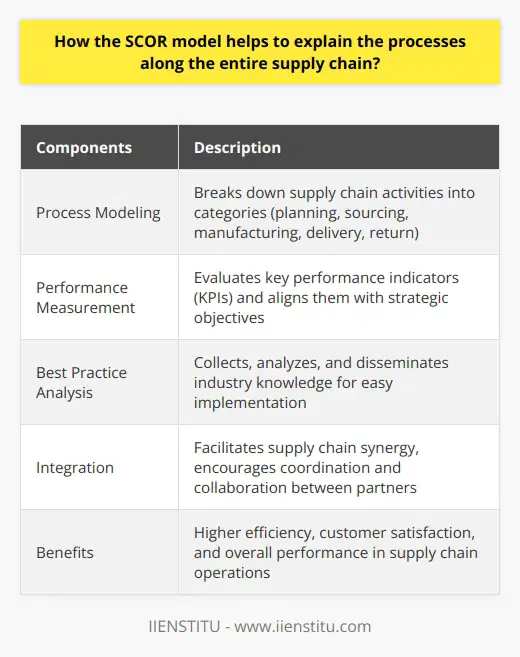
How is the SCOR model instrumental in enhancing supply chain performance?
Significance of the SCOR Model
The Supply Chain Operations Reference (SCOR) model is a recognized management tool that offers a robust framework for analyzing, optimizing, and benchmarking supply chain performance. By employing the SCOR model, organizations can systematically evaluate critical aspects of their supply chain and identify areas for improvement, ultimately leading to enhanced overall performance.
Process Standardization and Benchmarking
A key advantage of the SCOR model is its provision for standardized process definitions and performance metrics, enabling companies to compare their supply chain performance against industry best practices. This comparative approach facilitates the identification of performance gaps and encourages the adoption of proven strategies to achieve superior results.
Performance Measurement and Monitoring
The SCOR model provides a comprehensive set of performance indicators that measure the efficiency, effectiveness, and adaptability of supply chain processes. These indicators serve as a communication tool to align organizational goals, identify process inefficiencies, and prioritize improvement initiatives. Continuous monitoring of these metrics ensures sustained progress in supply chain performance.
Holistic Approach to Supply Chain Management
The SCOR model adopts a holistic approach, encompassing all core supply chain processes: plan, source, make, deliver, return, and enable. This comprehensive perspective allows organizations to scrutinize the entire supply chain and develop integrated strategies that address the interdependencies among processes and drive synergistic outcomes.
Collaboration and Risk Management
By promoting a collaborative approach to supply chain management, the SCOR model encourages organizations to share information and foster partnerships with key stakeholders, including suppliers, customers, and logistics providers. This collaborative mindset leads to a greater alignment of objectives, improved coordination of activities, and enhanced responsiveness to market fluctuations. Furthermore, the SCOR model emphasizes the importance of risk management in supply chain processes, enabling organizations to proactively identify potential threats, assess their impact, and devise mitigation strategies.
In conclusion, the SCOR model contributes significantly to enhancing supply chain performance through its focus on standardization, benchmarking, performance monitoring, holistic management, collaboration, and risk management. By adopting the principles and practices of the SCOR model, organizations can achieve substantial improvements in supply chain efficiency, effectiveness, and agility, ultimately leading to a competitive advantage in the marketplace.

Which metrics are involved in evaluating the effectiveness of the SCOR model in supply chain management?
Metrics in SCOR Model Evaluation
Key Performance Indicators
To evaluate the effectiveness of the Supply Chain Operations Reference (SCOR) model in supply chain management, one must consider several key performance indicators (KPIs). These metrics provide insights into the performance of various supply chain processes, enabling the assessment of the SCOR model's effectiveness.
Reliability Metrics
Firstly, reliability metrics are crucial for measuring delivery, responsiveness, and accuracy. Examples include perfect order fulfillment, on-time delivery, and order accuracy rates. High scores in these metrics indicate that the SCOR model is successfully ensuring efficiency and delivering value in the supply chain.
Responsiveness Metrics
Secondly, responsiveness metrics, such as order-to-delivery lead time and production flexibility, reveal the supply chain's agility. These metrics highlight the SCOR model's ability to adapt and respond to changing customer demands effectively and efficiently.
Cost Metrics
Thirdly, cost metrics, such as cost of goods sold and total supply chain management cost, directly impact the profitability of a business. Monitoring these metrics helps determine whether the SCOR model implementation leads to cost savings and improved operational performance.
Asset Management Efficiency
Additionally, asset management efficiency metrics, such as inventory days of supply and cash-to-cash cycle time, emphasize the effective utilization of assets. These metrics offer insights into how well the SCOR model optimizes resources, supporting a lean and efficient supply chain.
Sustainability Indicators
Lastly, sustainability indicators, such as carbon emissions, energy usage, and waste reduction, are increasingly vital for evaluating the SCOR model's effectiveness. These indicators provide a broader perspective on the supply chain's environmental and social impacts, enabling the assessment of the SCOR model's role in promoting corporate social responsibility and sustainable business practices.
In conclusion, a comprehensive evaluation of the SCOR model's effectiveness in supply chain management involves examining a wide range of metrics, including reliability, responsiveness, cost, asset management efficiency, and sustainability indicators. By analyzing these metrics, companies can determine the success of their SCOR model implementation and make informed decisions to enhance supply chain performance further.
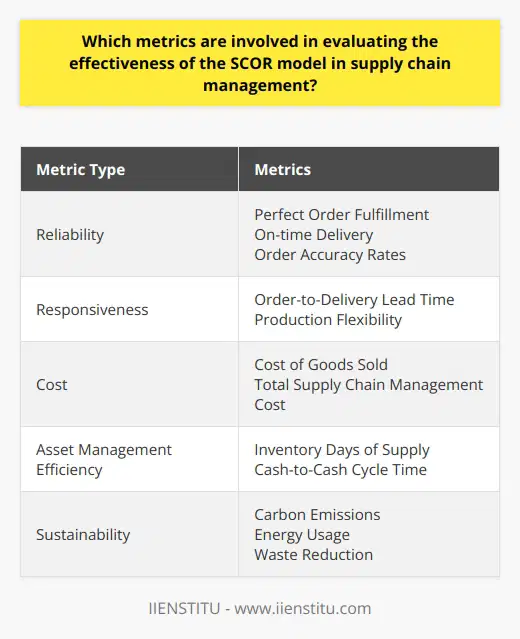
What are some real-world applications or case studies that demonstrate the benefits of the SCOR model in optimizing supply chain processes?
Real-World Applications of SCOR Model
**Enhancing Pharmaceutical Supply Chain**
One example of the SCOR model's application is in the pharmaceutical industry, where it has improved supply chain efficiencies and reduced costs. In a case study by Lockamy & McCormack (2004), the model was used to identify performance gaps and areas for improvement within a major global pharmaceutical company's supply chain. By adopting best practices, the company significantly reduced lead times, improved asset utilization, and increased customer satisfaction.
**Streamlining Automotive Manufacturing**
Another practical application of the SCOR model can be seen in the automotive manufacturing industry. As discussed by Gunasekaran & Spalanzani (2014), the model has been utilized to optimize supply chain processes within a European automotive organization. This led to improved inventory management, reduced stock-outs, increased order accuracy, and greater agility in responding to customer demands.
**Transforming Consumer Electronics Logistics**
Consumer electronics is another sector where the SCOR model has demonstrated its value in optimizing supply chain processes. According to Aghazadeh (2004), the model was applied to a major electronics retailer's logistics operations. The results included increased inventory turnover rates, lower stock levels, and improved customer order fulfillment rates, contributing to overall cost savings and enhanced customer satisfaction.
**Optimizing Chemical Industry Supply Chains**
In the chemical industry, the SCOR model has been used to optimize supply chain operations and enhance overall performance. Jacobs & Coussement (2008) explored the application of the model to a leading global chemical company, resulting in improved process efficiency, enhanced collaboration among supply chain partners, and better responsiveness to customer needs. Moreover, the company gained a competitive advantage by streamlining its operations and reducing costs.
In conclusion, the SCOR model has demonstrated its effectiveness in various industries, such as pharmaceuticals, automotive manufacturing, consumer electronics, and chemicals. By adopting the model's best practices and benchmarking performance metrics, companies have been able to optimize their supply chain processes, resulting in reduced costs, improved efficiency, and enhanced customer satisfaction. These real-world applications validate the benefits of the SCOR model for organizations seeking continuous improvement in supply chain management.
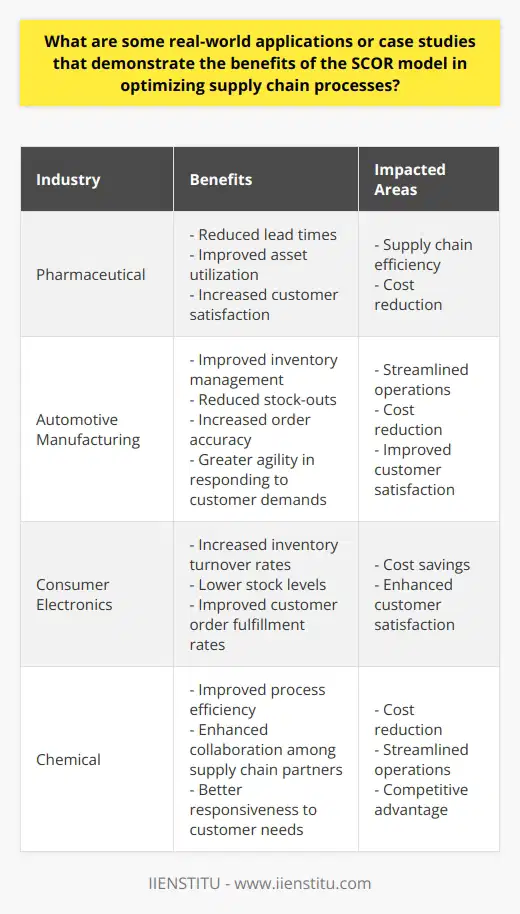
How do you use the SCOR model in supply chain to align business strategy with supply chain operations?
Utilizing SCOR Model in Strategy Alignment
The Supply Chain Operations Reference (SCOR) model serves as an effective tool to align business strategy with supply chain operations to achieve increased efficiency, reduced costs, and enhanced customer satisfaction. The SCOR model comprises five process levels: Plan, Source, Make, Deliver, and Return. By following these steps, companies can identify the optimal supply chain design to support their strategic goals.
Step 1: Plan
The planning stage involves developing a comprehensive supply chain strategy, including identifying key performance indicators (KPIs) and setting performance targets. This includes demand forecasting, inventory management, and production planning in line with the organization's strategic objectives.
Step 2: Source
During the sourcing stage, companies evaluate and select suppliers based on factors such as cost, quality, and lead time. Supplier relationship management plays a crucial role in ensuring a reliable and efficient supply chain. Sourcing decisions should be aligned with the company's overall objectives to maintain competitive advantage.
Step 3: Make
The make stage encompasses production processes, starting from raw materials and ending with finished goods. Effective resource planning, capacity optimization, and quality management practices are essential to meet demand and achieve operational excellence. Manufacturing strategies must be synchronized with the organization's wider business goals to deliver value to customers.
Step 4: Deliver
The deliver stage focuses on order management, warehousing, and transportation aspects of the supply chain. Efficient logistics processes contribute to reduced costs, improved delivery performance, and increased customer satisfaction. Delivery operations should be designed to support customer-centric strategies, including shorter lead times and superior product availability.
Step 5: Return
In the return stage, organizations manage product returns, handle customer complaints, and implement corrective actions to prevent recurring issues. A streamlined reverse logistics process enables improved sustainability and customer loyalty. Companies must align return policies with their strategic objectives to ensure effective resource recovery and minimize environmental impact.
Continuous Improvement and Performance Measurement
Continual monitoring and improvement are vital aspects of the SCOR model. By regularly reviewing KPIs and comparing them to industry benchmarks, organizations can identify areas for improvement and ensure continued alignment between supply chain operations and strategic goals.
In summary, the SCOR model provides a systematic approach to designing and managing an organization's supply chain processes. This alignment with the overall business strategy is essential to drive competitive advantage, meet customer expectations, and achieve operational excellence.
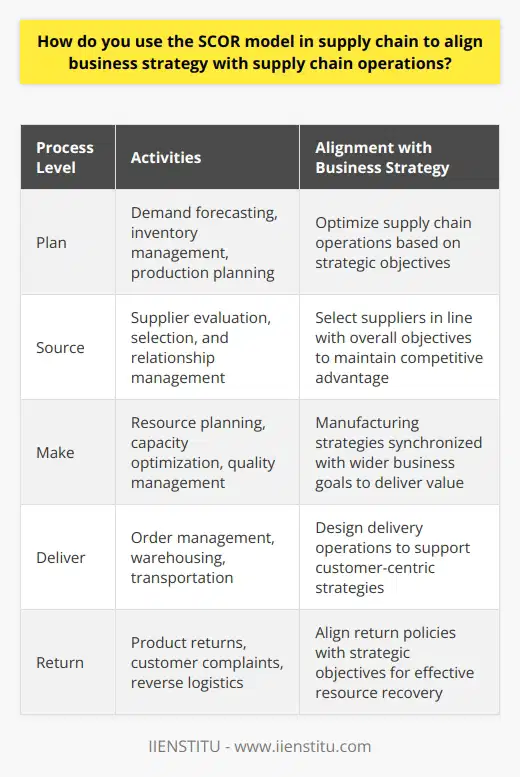
What are the best practices in implementing the SCOR model to ensure effective supply chain management?
SCOR Model Implementation
The Supply Chain Operations Reference (SCOR) model is an essential tool for effective supply chain management. To achieve the best results, organizations should follow specific best practices when implementing the SCOR model.
Establish Clear Goals
The first step is to establish clear goals and objectives that align with the organization's overall business strategy. Goals should be Specific, Measurable, Achievable, Relevant, and Time-bound (SMART). By defining clear targets, companies can effectively monitor progress and achieve desired outcomes.
Create a Cross-Functional Team
Successful SCOR implementation requires a cross-functional team that includes representation from various departments and levels within the organization. This team helps to promote communication, break down organizational silos, and ensure diverse perspectives are considered during the planning and implementation process.
Conduct a Gap Analysis
Conducting a gap analysis enables an organization to assess its current state of supply chain operations against the SCOR framework. This assessment highlights areas of inefficiency or underperformance, allowing the organization to focus on improvement initiatives that directly align with desired outcomes.
Develop a Detailed Implementation Plan
A comprehensive implementation plan is crucial to the success of the SCOR model. This plan should include detailed activities, tasks, and milestones for each improvement initiative. Additionally, it should establish clear roles and responsibilities for team members and outline potential risks and mitigation strategies.
Create Metrics and Performance Indicators
To measure progress and evaluate the effectiveness of SCOR implementation, organizations should develop a set of key performance indicators (KPIs). These metrics must align with the goals and objectives established during the planning phase, enabling the organization to continually monitor and gauge the impact of improvement initiatives.
Continuously Improve
The SCOR model encourages a continuous improvement mindset. Organizations should continually evaluate supply chain performance, identify areas for improvement, and adjust strategies based on changing business conditions or emerging trends. Regularly revisiting the SCOR framework helps organizations to remain agile, competitive, and better positioned for long-term success.
In conclusion, effectively implementing the SCOR model involves setting clear goals, building cross-functional teams, conducting gap analysis, developing a detailed implementation plan, creating performance metrics, and embracing continuous improvement. By following these best practices, organizations can optimize their supply chain operations, drive performance improvements, and ultimately achieve competitive advantage.
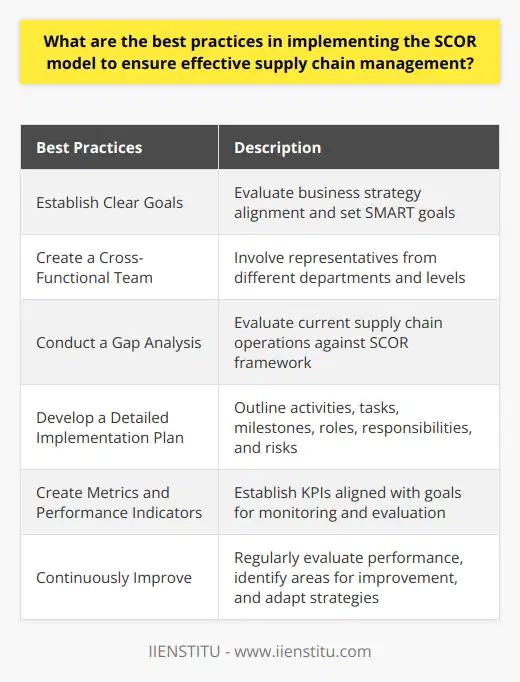
How do companies leverage the SCOR model for continuous improvement and performance benchmarking in supply chain operations?
Understanding SCOR Model Implementation
The Supply Chain Operations Reference (SCOR) model is a performance management framework that allows companies to assess and enhance their supply chain operations. By utilizing the SCOR model, businesses can identify performance gaps, adopt best practices, and align their supply chain strategies with overall business objectives for continuous improvement and performance benchmarking in supply chain operations.
Identifying Performance Gaps
Companies harness the SCOR model's diagnostic capabilities to determine performance gaps within their supply chain processes. This involves comparing their supply chain's key performance indicators (KPIs) with relevant industry benchmark data and identifying areas that require further improvement. The SCOR model thus provides a basis for continuous improvement by highlighting underperforming areas and determining the necessary actions to close these gaps.
Adopting Best Practices
The SCOR model includes a comprehensive set of standard practices and processes known as SCOR Level 2 - enabling companies to learn from industry leaders and apply best practices in their operations. By adopting these proven practices, organizations can streamline their supply chain processes, minimize inefficiencies, and enhance overall performance. This continual refinement of processes is crucial for achieving excellence in supply chain operations and staying competitive in the market.
Aligning Strategies with Business Objectives
An essential aspect of leveraging the SCOR model is ensuring that the supply chain strategy aligns with the company's overall business objectives. This alignment enables organizations to focus on specific supply chain goals that contribute to the corporate goals, thus driving continuous improvement from a strategic standpoint. The SCOR model helps companies by providing a structured framework to define and align supply chain performance metrics with broader business objectives.
Measuring Performance with Benchmarking
Performance benchmarking is a crucial component of the SCOR model, allowing companies to measure their supply chain performance against industry standards and identify areas for improvement. By comparing their KPIs with benchmark data, organizations can gauge their progress, focus on the most critical improvement opportunities, and track the impact of their continuous improvement efforts. This continuous measurement not only helps in improved decision making but also promotes a culture of performance-based management, guiding companies towards world-class supply chain operations.
In conclusion, companies can leverage the SCOR model for continuous improvement and performance benchmarking in supply chain operations by identifying performance gaps, adopting best practices, aligning strategies with business objectives, and measuring performance through benchmarking. This holistic approach enables organizations to optimize their supply chain processes, enhance overall performance, and ultimately drive business success.
